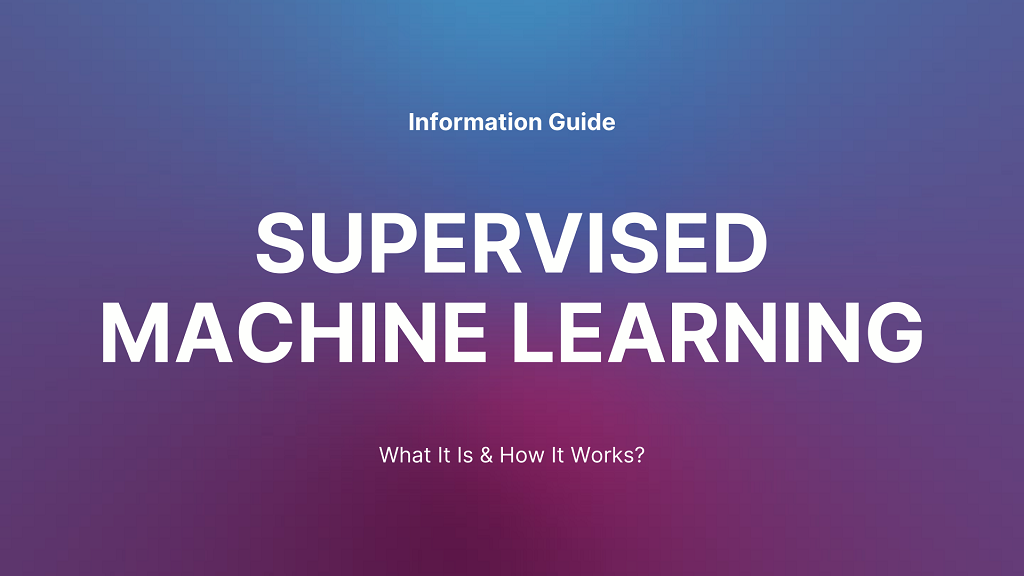Simple guide to Supervised Learning
Supervised learning is a cornerstone of machine learning subset of artificial intelligence that involves training algorithms on labeled data. This method teaches models to make predictions or decisions based on input-output pairs. It is an essential technique for various applications. These include image recognition, speech processing and predictive analytics. In this comprehensive guide we will explore the fundamentals of supervised learning, its key components algorithms and practical applications.
Fundamentals of Supervised Learning
Supervised learning operates on the principle of learning from examples. The process begins with a dataset comprising input-output pairs. Each input is associated with a correct output. The goal is to learn a mapping from inputs to outputs that can be generalized to new, unseen data.
Key Components
1. Training Data
The dataset used to train the model. It consists of input features (independent variables) and corresponding output labels (dependent variables). The quality and quantity of training data significantly influence the model's performance.
2. Features
These are the input variables used to make predictions. Features can be continuous, categorical, or a mix of both.
3. Labels
The output variables that the model aims to predict. Labels are the ground truth used to guide the learning process.
4. Model
The mathematical representation of the relationship between inputs and outputs. Various algorithms can be used to build the model.
5. Loss Function
A metric used to measure the difference between the predicted output and the actual output. The goal of training is to minimize the loss function.
6. Optimization Algorithm
A method used to adjust the model's parameters to minimize the loss function. Gradient descent is a commonly used optimization algorithm.
Algorithms in Supervised Learning
Supervised learning algorithms can be broadly categorized into regression and classification algorithms, based on the type of output they predict.
Regression Algorithms
Regression algorithms are used when the output variable is continuous. They aim to predict a numerical value based on input features.
1. Linear Regression
A simple algorithm that models the relationship between input features and the output as a linear function. It's easy to interpret and computationally efficient.
2. Polynomial Regression
An extension of linear regression that models the relationship as a polynomial function, allowing for more complex relationships between inputs and outputs.
3. Support Vector Regression (SVR)
Uses the principles of support vector machines to perform regression tasks, capable of handling both linear and non-linear relationships.
4. Decision Trees
Models that use a tree-like structure to make decisions based on input features. They are easy to interpret but can be prone to overfitting.
5. Random Forest
An ensemble method that combines multiple decision trees to improve performance and reduce overfitting.
Classification Algorithms
Classification algorithms are used when the output variable is categorical. They aim to predict the class or category to which an input belongs.
1. Logistic Regression
A linear model used for binary classification tasks. It estimates the probability that an input belongs to a particular class.
2. K-Nearest Neighbors (KNN)
A non-parametric algorithm that classifies inputs based on the classes of their nearest neighbors in the feature space.
3. Support Vector Machines (SVM)
Constructs hyperplanes in a high-dimensional space to separate different classes. It is effective in high-dimensional spaces and for non-linear classification.
4. Decision Trees
Similar to their use in regression, decision trees for classification partition the feature space into regions associated with different classes.
5. Random Forest
Combines multiple decision trees to improve classification performance and robustness.
6. Neural Networks
Composed of layers of interconnected nodes (neurons), neural networks can model complex relationships between inputs and outputs. They are the basis for deep learning models.
Practical Applications of Supervised Learning
Supervised learning has a wide range of applications across various domains. Here are some notable examples:
1. Image Recognition
Algorithms like convolutional neural networks (CNNs) are used to identify objects and patterns in images. Applications include facial recognition, medical imaging, and autonomous vehicles.
2. Natural Language Processing (NLP)
Supervised learning is employed in tasks such as sentiment analysis, language translation, and spam detection. Models like recurrent neural networks (RNNs) and transformers are commonly used in NLP.
3. Finance
Predicting stock prices, credit scoring, and fraud detection are some of the applications of supervised learning in the financial sector. Regression models and ensemble methods are often used for these tasks.
4. Healthcare
Supervised learning aids in disease diagnosis, patient risk assessment, and personalized treatment plans. Decision trees, random forests, and neural networks are popular in healthcare applications.
5. Marketing
Customer segmentation, churn prediction, and targeted advertising are driven by supervised learning algorithms. Classification models like logistic regression and SVM are commonly used.
Challenges and Considerations
While supervised learning is powerful, it comes with several challenges and considerations:
1. Quality of Data
The accuracy of supervised learning models heavily depends on the quality and quantity of training data. Noisy, biased, or incomplete data can lead to poor model performance.
2. Overfitting and Underfitting
Overfitting occurs when a model learns the training data too well, capturing noise and performing poorly on new data. Underfitting happens when the model is too simple to capture the underlying patterns in the data. Techniques like cross-validation and regularization help mitigate these issues.
3. Computational Complexity
Some algorithms, especially those involving large neural networks, require significant computational resources for training and inference. Efficient algorithms and hardware accelerations, such as GPUs, are often necessary.
4. Interpretability
While some models, like linear regression and decision trees, are easy to interpret, others, like deep neural networks, are often considered black boxes. Interpretability is crucial in domains where understanding the model’s decisions is essential, such as healthcare and finance.
